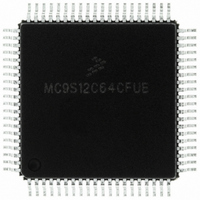MC9S12C64CFUE Freescale Semiconductor, MC9S12C64CFUE Datasheet - Page 163

MC9S12C64CFUE
Manufacturer Part Number
MC9S12C64CFUE
Description
IC MCU 64K FLASH 4K RAM 80-QFP
Manufacturer
Freescale Semiconductor
Series
HCS12r
Specifications of MC9S12C64CFUE
Core Processor
HCS12
Core Size
16-Bit
Speed
25MHz
Connectivity
CAN, EBI/EMI, SCI, SPI
Peripherals
POR, PWM, WDT
Number Of I /o
60
Program Memory Size
64KB (64K x 8)
Program Memory Type
FLASH
Ram Size
4K x 8
Voltage - Supply (vcc/vdd)
2.35 V ~ 5.5 V
Data Converters
A/D 8x10b
Oscillator Type
Internal
Operating Temperature
-40°C ~ 85°C
Package / Case
80-QFP
Processor Series
S12C
Core
HCS12
Data Bus Width
16 bit
Data Ram Size
4 KB
Interface Type
CAN/SCI/SPI
Maximum Clock Frequency
25 MHz
Number Of Programmable I/os
60
Number Of Timers
8
Maximum Operating Temperature
+ 85 C
Mounting Style
SMD/SMT
3rd Party Development Tools
EWHCS12
Development Tools By Supplier
M68EVB912C32EE
Minimum Operating Temperature
- 40 C
On-chip Adc
8-ch x 10-bit
Package
80PQFP
Family Name
HCS12
Maximum Speed
25 MHz
Operating Supply Voltage
2.5|5 V
Height
2.4 mm
Length
14 mm
Supply Voltage (max)
2.75 V, 5.5 V
Supply Voltage (min)
2.35 V, 2.97 V
Width
14 mm
Lead Free Status / RoHS Status
Lead free / RoHS Compliant
Eeprom Size
-
Lead Free Status / Rohs Status
Lead free / RoHS Compliant
Available stocks
Company
Part Number
Manufacturer
Quantity
Price
Company:
Part Number:
MC9S12C64CFUE
Manufacturer:
Freescale Semiconductor
Quantity:
10 000
- Current page: 163 of 690
- Download datasheet (4Mb)
5.6.3
The priority decoder evaluates all interrupts pending and determines their validity and priority. When the
CPU requests an interrupt vector, the decoder will provide the vector for the highest priority interrupt
request. Because the vector is not supplied until the CPU requests it, it is possible that a higher priority
interrupt request could override the original exception that caused the CPU to request the vector. In this
case, the CPU will receive the highest priority vector and the system will process this exception instead of
the original request.
If for any reason the interrupt source is unknown (e.g., an interrupt request becomes inactive after the
interrupt has been recognized but prior to the vector request), the vector address will default to that of the
last valid interrupt that existed during the particular interrupt sequence. If the CPU requests an interrupt
vector when there has never been a pending interrupt request, the INT will provide the software interrupt
(SWI) vector address.
5.7
The priority (from highest to lowest) and address of all exception vectors issued by the INT upon request
by the CPU is shown in
Freescale Semiconductor
Exception Priority
Interrupt Priority Decoder
0xFFFC–0xFFFD
0xFFFE–0xFFFF
0xFFFA–0xFFFB
0xFFF8–0xFFF9
0xFFF6–0xFFF7
0xFFF4–0xFFF5
0xFFF2–0xFFF3
0xFFF0–0xFF00
Vector Address
Care must be taken to ensure that all exception requests remain active until
the system begins execution of the applicable service routine; otherwise, the
exception request may not be processed.
Table
5-5.
Table 5-5. Exception Vector Map and Priority
System reset
Crystal monitor reset
COP reset
Unimplemented opcode trap
Software interrupt instruction (SWI) or BDM vector request
XIRQ signal
IRQ signal
Device-specific I-bit maskable interrupt sources (priority in descending order)
MC9S12C-Family / MC9S12GC-Family
Rev 01.24
NOTE
Source
Chapter 5 Interrupt (INTV1) Block Description
163
Related parts for MC9S12C64CFUE
Image
Part Number
Description
Manufacturer
Datasheet
Request
R
Part Number:
Description:
Manufacturer:
Freescale Semiconductor, Inc
Datasheet:
Part Number:
Description:
Manufacturer:
Freescale Semiconductor, Inc
Datasheet:
Part Number:
Description:
Manufacturer:
Freescale Semiconductor, Inc
Datasheet:
Part Number:
Description:
Manufacturer:
Freescale Semiconductor, Inc
Datasheet:
Part Number:
Description:
Manufacturer:
Freescale Semiconductor, Inc
Datasheet:
Part Number:
Description:
Manufacturer:
Freescale Semiconductor, Inc
Datasheet:
Part Number:
Description:
Manufacturer:
Freescale Semiconductor, Inc
Datasheet:
Part Number:
Description:
Manufacturer:
Freescale Semiconductor, Inc
Datasheet:
Part Number:
Description:
Manufacturer:
Freescale Semiconductor, Inc
Datasheet:
Part Number:
Description:
Manufacturer:
Freescale Semiconductor, Inc
Datasheet:
Part Number:
Description:
Manufacturer:
Freescale Semiconductor, Inc
Datasheet:
Part Number:
Description:
Manufacturer:
Freescale Semiconductor, Inc
Datasheet:
Part Number:
Description:
Manufacturer:
Freescale Semiconductor, Inc
Datasheet:
Part Number:
Description:
Manufacturer:
Freescale Semiconductor, Inc
Datasheet:
Part Number:
Description:
Manufacturer:
Freescale Semiconductor, Inc
Datasheet:











